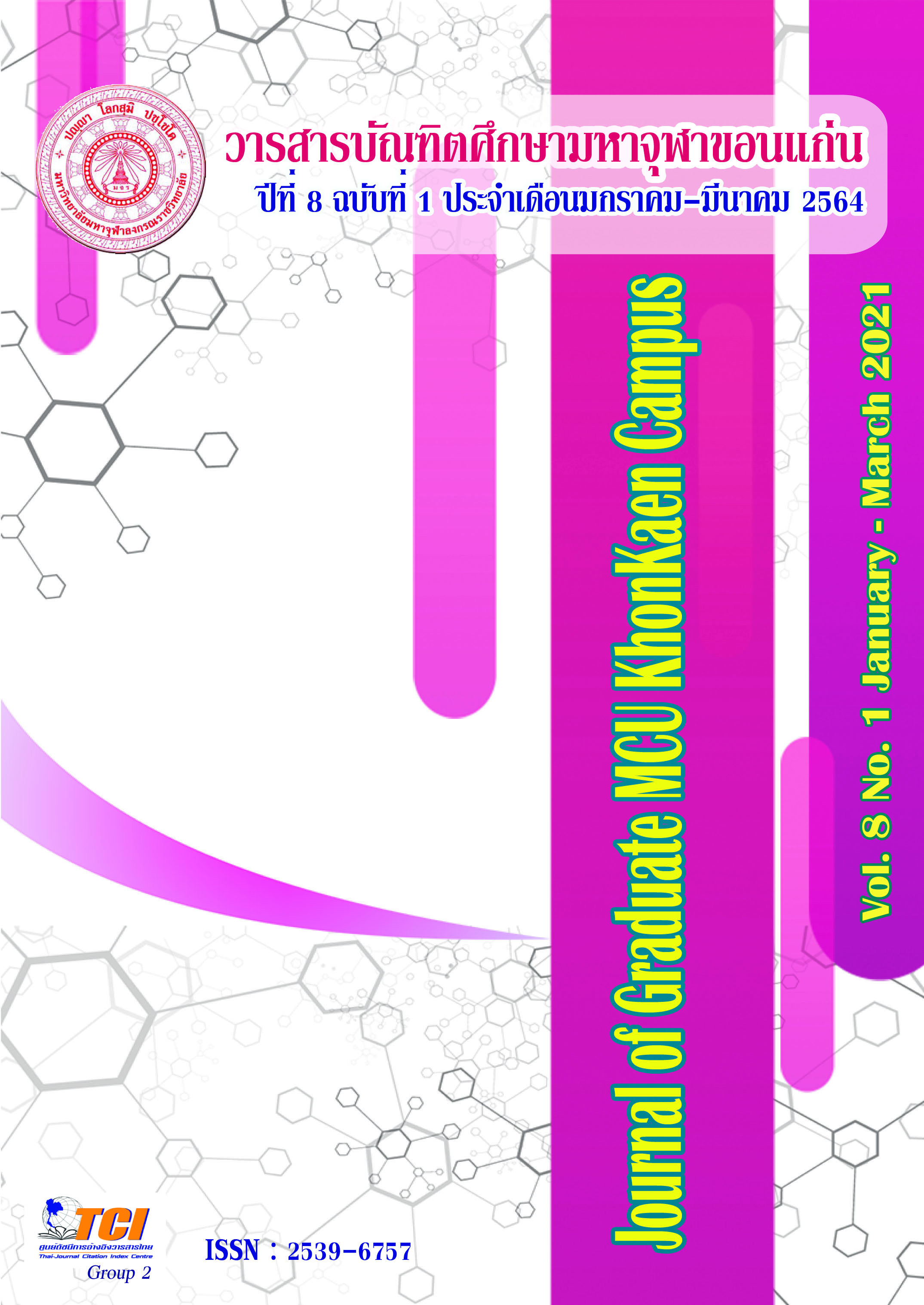การศึกษาวิเคราะห์ปรัชญาชีวิตของคนอีสานจากประติมากรรมปูนปั้นวัดโพธิ์ บ้านโนนทัน ตำบลในเมือง อำเภอเมือง จังหวัดขอนแก่น
Main Article Content
บทคัดย่อ
การวิจัยนี้มีวัตถุประสงค์เพื่อ 1) ศึกษาประวัติความเป็นมาของประติมากรรมปูนปั้นวัดโพธิ์ บ้านโนนทัน ตำบลในเมือง อำเภอเมือง จังหวัดขอนแก่น 2) ศึกษาพุทธจริยศาสตร์กับปรัชญาชีวิตชาวอีสานในประติมากรรมปูนปั้นวัดโพธิ์ บ้านโนนทัน ตำบลในเมือง อำเภอเมือง จังหวัดขอนแก่น และ 3) วิเคราะห์ปรัชญาชีวิตของคนอีสานจากประติมากรรมปูนปั้นวัดโพธิ์บ้านโนนทัน ตำบลในเมือง อำเภอเมือง จังหวัดขอนแก่น เป็นการวิจัยเชิงคุณภาพ เก็บข้อมูลจากเอกสาร และการสัมภาษณ์
เชิงลึกจากผู้ให้ข้อมูล 12 รูป/คน วิเคราะห์ด้วยการพรรณนาตามหลักอุปนัยวิธี
ผลการวิจัยพบว่า
1. ภาพประติมากรรมปูนปั้นวัดโพธิ์ เป็นสิ่งที่แฝงด้วยปรัชญาชีวิต สร้างขึ้นเพื่อสะท้อนวิถีชีวิตของคนอีสาน 4 ด้าน คือ 1) การถ่ายทอดประสบการณ์ 2) การอนุรักษ์ และถ่ายทอดศิลปวัฒนธรรม 3) การใช้สื่อเพื่อเผยแผ่ธรรมะ 5) การสื่อสารเชิงจริยธรรม ซึ่งในแต่ละด้านแฝงด้วยแนวคิดปรัชญาในรูปแบบของภาพปริศนาธรรม การอนุรักษ์ศิลปวัฒนธรรม เนื้อหา และความสวยงาม ซึ่งมีคุณค่าต่อศิลปวัฒนธรรม พระพุทธศาสนา และการศึกษา
2. ทฤษฎีพุทธจริยศาสตร์ว่าด้วยแนวคิด และแนวทางปฏิบัติเพื่อความดีงามแบ่งเป็น 3 ระดับ คือ ระดับต้น คือ ศีล 5 ระดับกลาง คือ กุศลกรรมบถ 10 และระดับสูง คือ มรรคมีองค์ 8 ส่วนปรัชญาชีวิตคนอีสานที่มีความสอดคล้องกับพุทธจริยศาสตร์ แบ่งเป็น 3 ระดับคือ 1) การดำเนินชีวิตเพื่อความสุขในปัจจุบัน 2) การดำเนินเพื่อความสุขในภายหน้า 3) การดำเนินชีวิตเพื่อความสุขสูงสุด
3. การวิเคราะห์ปรัชญาชีวิตของคนอีสานจากประติมากรรมปูนปั้นวัดโพธิ์ผ่านแนวคิดทางพุทธจริยศาสตร์โดยใช้วิธีการตีความ แบ่งเป็น 6 ด้าน คือ 1) พุทธจริยศาสตร์ในแง่ของประติมากรรมปูนปั้นที่ก่อให้เกิดสุนทรียภาพ 2) ปรัชญาชีวิตของคนอีสาน 3) วิธีการพุทธจริยศาสตร์ 4) ระดับของพุทธจริยศาสตร์ 5) ลักษณะของพุทธจริยศาสตร์ 6) วิธีการศึกษาพุทธจริยศาสตร์
Article Details
เอกสารอ้างอิง
กังสดาล อยู่เย็น. (2554). พลวัตชุมชนบ้านเปร็ดภายใต้แนวคิดเศรษฐกิจพอเพียง. ใน วิทยานิพนธ์พัฒนาชุมชนมหาบัณฑิต คณะสังคมสงเคราะห์ศาสตร์, บัณฑิตวิทยาลัย: มหาวิทยาลัยธรรมศาสตร์.
เนตรนภา แก้วแสงธรรม. (2551). การศึกษาหลักธรรมที่ปรากฏในจิตรกรรมฝาผนังที่มีอิทธิพลต่อวิถีชีวิตชาวจังหวัดอุบลราชธานี ศึกษาเฉพาะกรณีวัดทุ่งศรีเมือง วัดบ้านนาควายและวัดหนองมะนาว. ใน วิทยานิพนธ์พุทธศาสตรมหาบัณฑิต, บัณฑิตวิทยาลัย: มหาวิทยาลัยมหาจุฬาลงกรณราชวิทยาลัย.
ณัฐพล โสตถิรัตน์วิโรจน์. (2557). จริยศาสตร์ของการพัฒนา : บทสำรวจวิวาทะว่าด้วยการพัฒนา. วารสารปัญญาภิวัฒน์, 5(2), 274-288.
ผาสุก มุทธาเมธา. (2550). คติชาวบานกับการพัฒนาคุณภาพชีวิต. กรุงเทพมหานคร: บริษัท คอมแพคท์พริ้นท์ จำกัด.
พระธรรมปิฎก (ป.อ. ปยุตฺโต). (2557). วิธีคิดตามหลักพุทธธรรม. (พิมพ์ครั้งที่ 8). กรุงเทพมหานคร: สำนักพิมพ์ศยาม.
พระมหากฤษณะ ตรุโณ. (2559). การวิเคราะห์การดำเนินชีวิตของคนไทยในเชิงปรัชญา. สืบค้นเมื่อ 11 พฤศจิกายน 2559, จาก http://www.mcu.ac.th/site/articlecontent_desc.php?article_id=1610&articlegroup_id=299
เพ็ญแข บัวภา. (2553). การศึกษาเปรียบเทียบ หลักพุทธธรรมในโกอาน นิกายเซ็นและภาพปริศนาธรรมในศาลาโพธิสาร 72 วัดโพธิ์ บ้านโนนทัน อำเภอเมือง จังหวัดขอนแก่น. ใน วิทยานิพนธ์พุทธศาสตรดุษฎีบัณฑิต, บัณฑิตวิทยาลัย: มหาวิทยาลัยมหาจุฬาลงกรณราชวิทยาลัย.
นางโสภิตา จิวะพงศ์. (2553). ศึกษาวิเคราะห์การดำเนินชีวิตเชิงพุทธของผู้นำในสังคมไทย. ใน ปริญญาพุทธศาสตรมหาบัณฑิต สาขาวิชาพระพุทธศาสนา, บัณฑิตวิทยาลัย: มหาวิทยาลัยมหาจุฬาลงกรณราชวิทยาลัย.
สำนักงานคณะกรรมการพัฒนาเศรษฐกิจและสังคมแห่งชาติ สำนักนายกรัฐมนตรี. (2560). แผนพัฒนาเศรษฐกิจและสังคม แห่งชาติ (สศช.) ฉบับที่ 12 (พ.ศ. 2560 – 2564). กรุงเทพมหานคร: สำนักงานคณะกรรมการพัฒนาเศรษฐกิจและสังคมแห่งชาติ
สำนักงานคณะกรรมการพัฒนาการเศรษฐกิจและสังคมแห่งชาติ. (2559). แผนพัฒนาเศรษฐกิจและสังคมแห่งชาติ ฉบับที่ 12. สำนักงานคณะกรรมการพัฒนาการเศรษฐกิจและสังคมแห่งชาติ.

